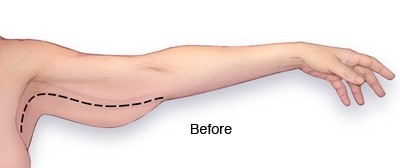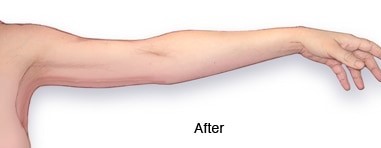Brachioplasty
other terms: Arm lift
An arm lift is a cosmetic surgical procedure to improve the appearance of the under portion of your upper arms.
During an arm lift — also known as brachioplasty — excess skin and fat are removed from between the armpit and elbow. The remaining skin is placed back over the newly repositioned contours to create a more toned look.
Why it’s done ?
As you get older, the skin on your upper arms changes — sagging and becoming loose. Significant weight loss also can cause the undersides of your upper arms to droop.
While exercise can strengthen and improve muscle tone in the upper arm, it can’t address excess skin that has lost elasticity.
You might choose to have an arm lift if the undersides of your upper arms are sagging. An arm lift might also boost your body image.
Risks
An arm lift poses various risks, including:
- Incision scars from an arm lift are permanent, but are typically placed in areas that aren’t easily visible. Rarely, incisions can result in raised, red scars. Injections of a corticosteroid medication or other treatments might be used to improve the appearance of scars.
- Asymmetry in the shape of your arms.This could occur as a result of changes during the healing process. Also, while the surgeon will try to make your arms look as symmetrical as possible, perfect symmetry isn’t possible.
- Changes in skin sensation.During an arm lift, the repositioning of your arm tissues can affect superficial sensory nerves. You’ll likely feel some temporary numbness.
- Problems with stitches.Stitches used to secure the arm’s new shape might work their way to the surface of the skin and need to be removed. This can cause inflammation of the affected skin. As a result, you might need additional surgery.
Like any other type of major surgery, an arm lift poses a risk of bleeding, infection and an adverse reaction to anesthesia.
An arm lift isn’t for everyone. Your doctor might caution against an arm lift if you:
- Are significantly overweight
- Have frequent changes in your weight
- Have a medical condition that interferes with wound healing
- Are a smoker
How you prepare
Initially, you’ll talk to a plastic surgeon about an arm lift. During your first visit, your plastic surgeon will likely:
- Review your medical history.Be prepared to answer questions about current and past medical conditions. Talk about any medications you’re taking or have taken recently, including over-the-counter drugs and herbal supplements, as well as any surgeries you’ve had.
- Do a physical exam.To determine your treatment options, the doctor will examine the undersides of your upper arms. The doctor will also take pictures of your arms for your medical record.
- Discuss your expectations.Explain why you want an arm lift and what you’re hoping for in terms of appearance after the procedure. Make sure you understand the benefits and risks, including scarring.
- If you use tobacco, stop.Smoking decreases blood flow in the skin and can slow the healing process. If you smoke, your doctor will advise you to stop smoking before surgery and during recovery. Some doctors won’t perform the surgery if you still smoke because the risk of complications is higher.
What you can expect ?
An arm lift can be done in a hospital or an outpatient surgical facility.
Sometimes the procedure is done with sedation and local anesthesia, which numbs only part of your body. In other cases, general anesthesia — which renders you unconscious — is recommended.
Before the procedure
- Avoid certain medications.You’ll likely need to avoid taking aspirin, anti-inflammatory drugs and herbal supplements, which can increase bleeding.
- Arrange for help during recovery.Make plans for someone to drive you home after surgery and stay with you as you begin to recover.
During the procedure
Your plastic surgeon will make incisions on the undersides of your arms. The length and pattern of the incisions depends on how much skin will be removed.
After making the incisions, the plastic surgeon will tighten your underlying tissues and secure them with stitches. He or she might also use a suction technique to remove fat (liposuction).
Your skin will then be draped over the new contours and excess skin will be removed. Stitches or surgical tape will be used to close the incisions.
After the procedure
After an arm lift, your incisions will be covered in bandages. Your arms will be loosely wrapped in elastic bandages to minimize swelling. Small tubes might be placed in your arms to drain any excess blood or fluid.
You’ll likely see someone from your plastic surgery team within a day or two after your arm lift. He or she may remove your bandages and drainage tube if used. Some plastic surgeons may have you wear a compression sleeve for a few weeks to keep swelling down.
In the first few days after an arm lift:
- Avoid lifting your arms above shoulder level for three to four weeks.
- Avoid physical and athletic activities with your arms that might stretch the incisions for four to eight weeks after surgery.
- Take pain medication as needed and use topical or oral antibiotics as directed to prevent wound infections.
Talk to your doctor about when — or if — your stitches will be removed. Some stitches dissolve on their own. Others must be removed in the doctor’s office in the weeks after the procedure.
After an arm lift, contact your doctor immediately if you have:
- Shortness of breath
- Chest pains
- An irregular heartbeat
- Redness of the skin and a fever


Results
By removing loose skin, an arm lift can give your upper arms a more toned appearance.
Arm lift results are typically long lasting. Remember, however, your skin will naturally lose some firmness as you age and some sagging might occur. Maintaining a stable, healthy weight can help you retain your results.